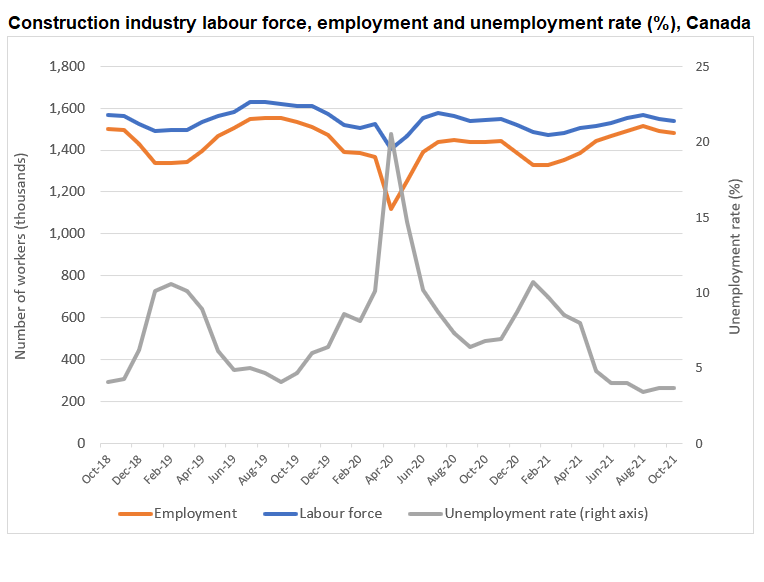After finally surpassing pre-pandemic levels in September, all-industry, seasonally adjusted employment numbers held steady in October.
The latest Labour Force Survey (LFS) issued by Statistics Canada on November 5 shows a gain in employment of 31,000 jobs, or 0.2% compared to the month previous. The national unemployment rate also continued to trend downward, with a drop of 0.2 percentage points for the month. October’s unemployment rate of 6.7% is the lowest seen in 20 months and is within one percentage point of the 5.7% rate seen in February 2020. Additionally, the adjusted unemployment rate – which includes people who wanted a job, but did not look for one – reached 8.7%, the lowest rate since the onset of the pandemic.

Statistics Canada collected data for its most recent LFS during the week of October 10 to 16 – a time when various provinces and workplaces had proof-of-vaccination initiatives in place, and when British Columbia, Ontario and Quebec had lifted capacity limits for many indoor gatherings where proof of vaccination was mandatory.
Construction employment dips again
The seasonally unadjusted employment numbers for construction show a different trend to the overall national picture.
October marked the second month in a row in which employment declined slightly. Following on the heels of the 1.6% drop in employment in September, the industry shed a further 8,700 workers (-0.6%) in October. Both reductions are likely due to the cyclical nature of the industry, with work wrapping up on projects that may be affected by the colder weather.
Employment in October was 3.4% (48,800 workers) higher than a year ago, but remained 3.5% (-53,100 workers) below 2019 levels. For context, it is important to note that employment reached record levels in 2019. When compared to previous years, employment in October 2021 exceeded historic levels.
Three of the four Atlantic provinces reported notable month-over-month gains in employment in October. New Brunswick led the way at 6%, with Prince Edward Island (4.9%) and Newfoundland and Labrador (4.7%) following. Only Nova Scotia (-1.4%) reported a loss for the month.
Among the remaining provinces, Saskatchewan reported a gain of 2.2% and British Columbia saw an increase of less than 1%. The remaining provinces all experienced declines, with Manitoba (-2.7%) reporting the largest drop.
Compared to a year ago, October employment levels dropped in four provinces: Prince Edward Island (-4.5%), Alberta (-3.0%), Nova Scotia (-1.7%), and Manitoba (-1.2%). The remaining provinces all reported increases in employment, with Saskatchewan (8.2%) and Quebec (7.8%) reporting the most notable gains.
Construction’s national unemployment rate was unchanged in October. The rate of 3.7% is 3.1 percentage points lower than October 2020, and one point lower than October 2019.
Most provinces reported increases in their unemployment rates in October. At 2.8%, Nova Scotia’s was the largest increase. Alberta and Newfoundland and Labrador also reported notable increases – 2.2% and 2.0% respectively.
Prince Edward Island, meanwhile, reported the most notable decline among provincial unemployment rates, with a drop of 4.5 percentage points. Quebec (-1.5 percentage points), Ontario (-1 percentage point), and Saskatchewan (-0.5 percentage points) also reported monthly drops in their unemployment rates.
After six months of continuous growth, the construction industry lost workers for the second consecutive month in October (-9,700). The number of workers in the national construction labour force is 1,539,500. This figure is consistent with the October 2020 labour force, but 4.5% (-71,700 workers) lower than October 2019 levels. Saskatchewan, Quebec, Ontario, Nova Scotia, and British Columbia all reported year-over-year gains in their construction labour forces, while Alberta (-8.3%) recorded the most notable annual decline.
Finally, hours worked across the country dropped by more than 9% in October. Despite that fact, the industry continues to operate at a much greater capacity than this time last year.
National total hours worked in October 2021 are up 4.4% from October 2020 levels. Hours have yet to return to pre-COVID levels but are within 1.6% of the hours reported in October 2019.
Prince Edward Island (-15.4%), Manitoba (-7.5%), and Nova Scotia (-3.0%) reported significantly fewer hours worked year over year, while New Brunswick, Newfoundland and Labrador, and Ontario reported declines of less than 1%.
The remaining provinces reported year-over-year gains, with Quebec experiencing the most notable increase of 15.2% from October 2020 levels.

